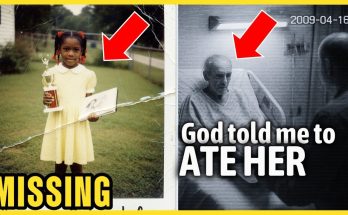After 20 Years, Here’s What FBI Found in The Natalee Holloway Mystery, And It’s Not Good | HO
:max_bytes(150000):strip_icc():focal(999x0:1001x2)/natalee-holloway-wide-932bd4b6da0d48649ca2c3bdef686934.jpg)
**On May 30, 2005, Natalee Holloway vanished from the Caribbean island of Aruba, launching one of the most notorious missing persons cases in modern American history. Two decades later, the FBI finally got the answer her family—and the world—had waited for.
But the final truth is not a triumph of justice. It’s a chilling confession, a timeline of deception, and a warning about how killers can use time, media, and legal loopholes to escape accountability._
The Vanishing That Froze a Nation
Natalee Holloway was an 18-year-old honors student from Alabama, celebrating her high school graduation with classmates on the sun-soaked beaches of Aruba. On her last night, she was seen leaving Carlos’n Charlie’s nightclub with three local men: Joran van der Sloot and brothers Deepak and Satish Kalpoe.
By morning, Natalee was gone. Her disappearance triggered a frantic search. Her parents flew in, mobilizing Aruban police, volunteers, and even tourists. Flyers blanketed the island. Beaches were combed. Nothing surfaced—not a phone, not a shoe, not a body.
The case immediately caught national headlines. American news networks descended on Aruba, turning Natalee’s disappearance into a 24-hour media event. Her mother, Beth Holloway, became the face of the search—her grief and determination fueling public interest and pressure on local authorities.
But from the start, the investigation was chaotic and mismanaged. The suspects’ stories shifted constantly. First, they claimed they dropped Natalee at her hotel. Later, they said she stayed at the beach. The inconsistencies fueled public outrage and suspicion, but there was a problem: no physical evidence, no eyewitnesses, and no confession.
Under Aruban law, suspects could be detained on suspicion, but without hard evidence, they had to be released. That’s exactly what happened.
As weeks turned to months, the investigation stalled. Despite extensive searches—including cadaver dogs, satellite imaging, and even Dutch military jets with infrared sensors—no new clues emerged.
The trail went cold. But the Holloway family never stopped searching, launching independent investigations and pressuring authorities. The FBI, while lacking jurisdiction, quietly stayed involved, analyzing tips and evidence, waiting for someone to break their silence.
Two Decades of Dead Ends and Lies
What followed was a masterclass in evasion and deception. Joran van der Sloot’s statements to police changed repeatedly. He claimed he dropped Natalee off at her hotel, then said they stayed at the beach, then insisted he was dropped off at home while the Kalpoes drove Natalee elsewhere.
None of these stories matched surveillance or phone records. The Kalpoe brothers contradicted him, adding to the confusion. Police even caught the suspects arguing about the night’s events on surveillance.
Aruban authorities, under pressure, arrested several people based on speculation—including two security guards and a local DJ. None were connected to Natalee’s disappearance. Each release eroded public confidence further. The FBI offered logistical and forensic support but, without jurisdiction, their influence was limited.

Meanwhile, van der Sloot inserted himself into the media cycle, granting interviews and making vague admissions before retracting them. In 2008, a Dutch journalist aired secret recordings of van der Sloot confessing to being present when Natalee died and helping dispose of her body.
When confronted, he shrugged it off as fiction—a story told to impress someone he thought was a drug dealer. His behavior grew increasingly erratic and exploitative.
In 2010, van der Sloot contacted Beth Holloway, claiming he would reveal Natalee’s remains for $250,000. She paid a down payment. He gave her false information.
The FBI, monitoring the exchange, charged him with extortion and wire fraud in the U.S. But by then, van der Sloot had fled to Peru, where he murdered 21-year-old Stephany Flores. He was convicted and sentenced to 28 years.
Despite mounting circumstantial evidence and his admitted involvement, van der Sloot faced no charges for Natalee’s murder. Aruban law, with its statute of limitations and lack of forensic proof, meant the case remained stalled.
For nearly two decades, van der Sloot used his knowledge as a bargaining chip, dangling hope and closure in front of a grieving family and a captivated public.
The Confession—Too Little, Too Late
In 2023, the FBI finally got what they’d waited for: a credible, detailed confession. It didn’t come from a dramatic forensic breakthrough, but as part of a plea deal in a U.S. courtroom, where van der Sloot faced extortion and wire fraud charges. In exchange for a reduced sentence, he agreed to tell the truth about what happened to Natalee Holloway.
His confession was chilling. In a sworn proffer, van der Sloot admitted he attempted to sexually assault Natalee on the beach. When she resisted, kicking him in the groin, he responded with violence—kicking her in the face, then striking her with a cinder block until she died. He dragged her body into the sea, letting the ocean erase the evidence.
:max_bytes(150000):strip_icc():focal(749x0:751x2)/natalee-holloway-people-cover-tout-2-6a6b8c6d34144b11837b17dc04103c0a.jpg)
The confession was not a performance for the cameras. It contained details only the killer could know, aligning with circumstantial evidence the FBI had quietly collected over the years but could never act on. Yet the tone was clinical, detached—no remorse, no apology, just cold acknowledgment.
Beth Holloway called it both a victory and a devastation. “It’s over,” she told the media. “Joran van der Sloot is no longer a suspect. He is the killer.” After 18 years, she had an answer—but it came from the man who had tormented her with lies and false hope for nearly two decades.
Anatomy of a Manipulator
Van der Sloot’s confession didn’t just close a case. It exposed a disturbing psychological profile the FBI had long suspected. His behavior followed a consistent pattern: control, deception, exploitation. He used his position as the last person seen with Natalee to manipulate the narrative, shifting blame and changing his story whenever suspicion grew. When media attention surged, he leaned in, granting interviews and floating false confessions. Each version seemed designed to confuse rather than clarify.
His most egregious act came in 2010, when he extorted Natalee’s mother for information he never intended to give. The FBI, already monitoring him, gathered enough evidence for a conviction—but it was for financial crimes, not murder.
Five years after Natalee’s disappearance, van der Sloot killed again—murdering Stephany Flores in Peru after she rejected his advances. Again, he tried to cover it up. The pattern was clear: a manipulator who thrived on power over women, using secrecy as a weapon.
In the end, his confession in the Holloway case was another act of control—offered only when it served his legal interests.
Justice, But Not Really
When van der Sloot confessed to Natalee’s murder in 2023, many expected closure. What followed felt more like a bureaucratic compromise. Despite admitting to killing her, van der Sloot is unlikely to face criminal charges for the murder itself. Aruba’s statute of limitations for homicide is 12 years. Natalee disappeared in 2005; the confession came nearly two decades later.

Aruban prosecutors have left the case open, but legal constraints may protect him from prosecution. The only charges van der Sloot has faced in the U.S. relate to extortion. He pleaded guilty in 2023 and received a 20-year sentence, to run concurrently with his 28-year sentence in Peru. He may never spend a day in prison for killing Natalee Holloway.
For Beth Holloway, this is the closest she will ever get to justice. For the FBI and federal prosecutors, the plea deal was pragmatic. It allowed them to close a high-profile cold case with a verified confession. But for the public and Natalee’s family, it underscored a harsh reality: legal justice doesn’t always align with moral justice.
Forensics and the Limits of Science
For nearly two decades, the FBI and Aruban authorities chased a phantom—no body, no weapon, no conclusive forensic evidence. Early blunders by local police complicated everything. Surveillance footage was inconclusive. Potential crime scenes were contaminated or overlooked. The FBI analyzed duct tape with blonde hair, drained ponds, and searched landfills. Nothing connected definitively to Natalee. The ocean, if it held any clues, gave them up to the tides.
The lack of forensic evidence was not for lack of effort—it was the result of a perfectly executed cover-up. Van der Sloot himself described how the beach allowed him to erase all traces. No body meant no murder charge.
Ultimately, the FBI closed the case not with a body or forensic report, but with a transcript—a confession in a courtroom deal. It was the only form of resolution possible. And that’s what makes the case so tragic: it wasn’t just what the FBI found, but everything they couldn’t.
The Media Machine
From the moment Natalee was reported missing, her case became a media spectacle. Networks flooded Aruba, turning her disappearance into a nightly drama. The coverage shaped public opinion and pressured authorities, but it also blurred the lines between justice and entertainment. Van der Sloot used the spotlight to his advantage, manipulating the narrative and prolonging the agony for Natalee’s family.
The case also sparked conversations about media bias—why some missing persons cases become national obsessions while others, especially those involving people of color, are ignored. Aruba’s tourism industry suffered, and the island’s reputation was forever changed.
In the end, media attention both helped and hurt. It kept pressure on authorities, but it also ensured the Holloway family’s grief was lived in public, without pause.
What We’re Left With
After 20 years, here’s what the FBI found in the Natalee Holloway mystery—and it’s not good. There was no forensic breakthrough, no dramatic arrest, just a confession from a killer who gave up the truth when it no longer cost him anything. Natalee’s remains were never recovered. There was no justice in the traditional sense. What we’re left with is a name that echoes through decades of media, courtrooms, and grief: Joran van der Sloot.
Natalee Holloway became a symbol of lost potential, parental perseverance, and a justice system that sometimes fails those who need it most. The FBI kept her case active for nearly two decades because the truth always felt just out of reach. Now that it’s here, it feels hollow.
The warning is clear: killers can use media, legal loopholes, and time itself as a shield. Van der Sloot wasn’t just hiding a crime—he was leveraging it, using grief as a tool and hope as bait. Even with the truth in hand, the system could not deliver closure.
For Natalee’s family, there may be an answer, but there is no comfort. For the rest of us, there’s only the lesson that sometimes, truth is not enough.



